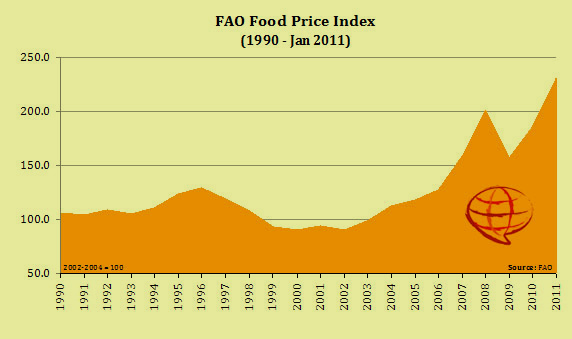![Wheat from Nepal. [Photo: shashish Flickr account]](https://www.unitedexplanations.org/wp-content/uploads/2011/02/3513581900_deca2b53c6_z.jpg)
Again, new max in food prices…
According to the FAO In December 2010, the FAO Food Price Index averaged 215 points, up 4 percent from November and 1 point above its peak in early summer 2008. The highest increases were recorded for the Sugar and Oils and Fats price indices. The December 2010 index was up 25 percent from December 2009. The Cereal Price Index rose to 238 points, up 6 percent from November and as much as 39 percent from December 2009. However, it remained still 13 percent (or 36 points) below its peak in June 2008.
The FAO Food Price Index
Consists of the average of 5 commodity group price indices mentioned above weighted with the average export shares of each of the groups for 2002-2004: in total 55 commodity quotations considered by FAO commodity specialists as representing the international prices of the food commodities noted are included in the overall index.
Which are the main drivers?

World population, supply and demand: the growth in the world’s population, which is expected to top nine billion by the middle of the century, put pressure on a range of resources, including land, water and oil, as well as food supply.
Changing diets in emerging countries: With demand for meat (which in turn requires feed grains to feed the livestock) and dairy products rising fast in rapidly growing economies such as India and China, producers struggle to keep up with demand.
Environmental factors: in 2010, severe weather in some of the world’s biggest food exporting countries damaged supplies. That has helped to push food prices almost 20% higher than a year earlier, according to the FAO.
Biofuel production: the shift in agricultural production from food to biofuels. Ethanol production is on course to account for some 30% of the US corn crop by 2010, dramatically curtailing the amount of land available for food crops and pushing up the price of corn flour on international commodity markets.
Traders influence: some political leaders are raising questions about how much investors such as commodities traders and hedge funds might be contributing to the run-up. France, which holds the presidency of the Group of 20, is pushing for tighter regulation and transparency in the trading of commodities, including derivatives trading.
Fueling revolutions
Food prices put especial pressure on developing countries’ middle classes. As we can see these days the politically powerful Egyptian middle class have had to devote more and more of their paychecks to simply staying alive. Food prices can trigger into street clashes in poor and volatile populations like Egypt where up to 40% of a family budget is intended only to get food.
This is a nonprofit explanation
¿Quieres recibir más explicaciones como esta por email?


One comment
Saandra
02/04/2011 at
very goood!